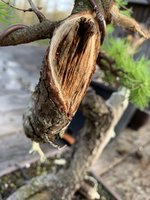Vincent Tanner
Mame
I purchased this American Larch last Fall. It was collected some years ago from a peat bog in Maine by the Black Dodge Bonsai duo, John Rough and Kris Springer.

I had been wanting a Larch for a while. It’s an awesome species for bonsai here in New England, and all the cool kids have them!
And they don’t mind the cold one bit!

The tree was overgrown, and the upper trunk was a bit too long without much taper. And the rectangle pot isn’t quite right for the tree.
I recently join a multi-year study group with Suthin Sukosolvisit, and this Larch is one of the trees I’ll be developing with him.

Suthin agreed with me about shortening the apex, so I chopped it and made a jin. Some other branches also got chopped and jin’d. I wired most of the remaining branches down.
We decided to look for a hexagonal pot for the future. So I’m on the lookout.

I’ll be working on maximizing health and promoting back budding and foliage density.
More updates to come has things move along.

I had been wanting a Larch for a while. It’s an awesome species for bonsai here in New England, and all the cool kids have them!
And they don’t mind the cold one bit!

The tree was overgrown, and the upper trunk was a bit too long without much taper. And the rectangle pot isn’t quite right for the tree.
I recently join a multi-year study group with Suthin Sukosolvisit, and this Larch is one of the trees I’ll be developing with him.

Suthin agreed with me about shortening the apex, so I chopped it and made a jin. Some other branches also got chopped and jin’d. I wired most of the remaining branches down.
We decided to look for a hexagonal pot for the future. So I’m on the lookout.

I’ll be working on maximizing health and promoting back budding and foliage density.
More updates to come has things move along.
Last edited:








